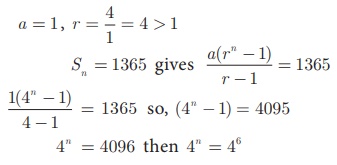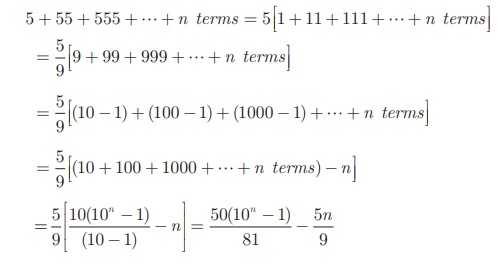Theorem, Example, Solution | Mathematics - Sum to n/infinite terms of a G.P.(Geometric Progression) | 10th Mathematics : UNIT 2 : Numbers and Sequences
Chapter: 10th Mathematics : UNIT 2 : Numbers and Sequences
Sum to n/infinite terms of a G.P.(Geometric Progression)
Sum
to n terms of a G.P.
A series whose terms are
in Geometric progression is called Geometric series.
Let a, ar,
ar2 , ...arn-1 , ... be the
Geometric Progression.
The sum of first n
terms of the Geometric progression is
Sn = a +ar +
ar 2 + + arn −2 +arn−1
... (1)
Multiplying both sides
by r, we get rSn = ar +ar2
+ ar3 + + arn −1 +arn
… (2)
(2)−(1) gives rSn − S n = arn –a
Sn (r
−1) = a(rn –1)
Thus, the sum to n terms
is 
Note
The above formula for
sum of first n terms of a G.P. is not applicable when r =
1.
If r = 1 , then
Sn = a + a +
a + + a = na
Progress Check
1. A series whose
terms are in Geometric progression is called _______.
2. Whenr = 1 ,
the formula for finding sum to n terms of a G.P. is ______.
3. Whenr ≠ 1 ,
the formula for finding sum to n terms of a G.P. is ______.
Sum to infinite terms of a G.P.
The sum of infinite
terms of a G.P. is given by a + ar +ar 2
+ ar 3 +….. = a /(1-r), -1 < r < 1
Example 2.46 Find the sum of 8 terms of the G.P. 1, − 3, 9, −27…
Solutions
Here the first term a
= 1 , common ratio r = -3/1 = -3 < 1, Here n = 8.
Sum to n terms of
a G.P. is

Example 2.47
Find the first term of a
G.P. in which S6 = 4095 and r = 4.
Solution
Common ratio = 4 > 1
, Sum of first 6 terms S6 = 4095

First term a =
3 .
Example 2.48
How many terms of the
series
1 + 4 + 16 + make the sum 1365 ?
Solution
Let n be the number of terms
to be added to get the sum 1365

4n
= 4096 then 4n = 46
n = 6
Example 2.49
Find the sum 
Solution Here a = 3 , 
Sum of infinite terms = 
Example 2.50
Find the rational form
of the number 0.6666¼
Solution
We can express the
number
0.6666¼as follows
0.6666… = 0.6 + 0.06 +
0.006 + 0.0006 +
We now see that numbers
0.6, 0.06, 0.006 ... forms an G.P. whose first term a = 0.6
and common ration r
= 0.06 / 0.6 = 0.1 . Also − 1 < r = 0.1 < 1
Using the infinite G.P.
formula, we have
0.6666... = 0.6 + 0.06 +
0.006 + 0.0006 + ... = 
Thus the rational number
equivalent of 0.6666 is 2/3
Example 2.51
Find the sum to n terms of the series 5 + 55 + 555 + ...
Solution
The series is neither
Arithmetic nor Geometric series. So it can be split into two series and then find the
sum.

Example 2.52
Find the least positive
integer
n such that 1 + 6 + 62 + + 6n > 5000
Solution
We have to find the
least number of terms for which the sum must be greater than 5000.
That is, to find the
least value of n. such that Sn > 5000
We have

6n
-1 > 25000 gives 6n > 25001
Since,
65 = 7776 and 66 =46656
The least positive value
of n is 6 such that 1 + 6 + 62 + + 6n
> 5000.
Example 2.53
A person saved money
every year, half as much as he could in the previous year. If he had totally
saved ₹ 7875 in 6 years then how much did he save in the first year?
Solution
Total amount saved in 6 years is S6 = 7875
Since he saved half as
much money as every year he saved in the previous year,
We have r = ½
< 1

The amount saved in the
first year is ₹ 4000.
Related Topics